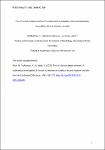Two of a Kind or Distant Relatives?
| dc.contributor.author | Ruch, W | |
| dc.contributor.author | Vylobkova, Valentina | |
| dc.contributor.author | Heintz, Sonja | |
| dc.date.accessioned | 2024-01-11T15:12:59Z | |
| dc.date.available | 2024-01-11T15:12:59Z | |
| dc.date.issued | 2023-10 | |
| dc.identifier.issn | 1614-0001 | |
| dc.identifier.issn | 2151-2299 | |
| dc.identifier.uri | https://pearl.plymouth.ac.uk/handle/10026.1/21897 | |
| dc.description.abstract |
Abstract: Allport’s distinction of personality devaluated (personality) and personality evaluated (character) raised the question of whether the character is redundant with personality, which still remains open today. The present study hence compares the Five-Factor Model of personality and the VIA-classification (Values in Action) of character strengths across two methods (self- and peer-reports) and two levels of abstraction (domains/factors and scales/facets). A sample of 152 participants and 152 peer-raters completed the NEO-Personality Inventory-Revised and the VIA Inventory of Strengths (VIA-IS). Personality and character assessed with these inventories were found to strongly overlap, yet the different operationalizations were rarely redundant (except for three personality facets). Multitrait-multimethod analyses mostly supported the convergent and discriminant validity of personality and character. Interpersonal strengths (e.g., teamwork) and abstract character factors lacked discriminant validity to personality facets. The present investigation contributes to a better understanding of the interplay between personality and character and provides an impetus for future research on the “virtue gap” between devaluated and evaluated personality traits. | |
| dc.format.extent | 263-270 | |
| dc.language | en | |
| dc.publisher | Hogrefe Publishing Group | |
| dc.subject | five-factor model of personality | |
| dc.subject | Big Five | |
| dc.subject | character strengths | |
| dc.subject | virtues | |
| dc.subject | personality facets | |
| dc.subject | positive psychology | |
| dc.title | Two of a Kind or Distant Relatives? | |
| dc.type | Journal Article | |
| plymouth.author-url | https://www.webofscience.com/api/gateway?GWVersion=2&SrcApp=PARTNER_APP&SrcAuth=LinksAMR&KeyUT=WOS:000999467900003&DestLinkType=FullRecord&DestApp=ALL_WOS&UsrCustomerID=11bb513d99f797142bcfeffcc58ea008 | |
| plymouth.issue | 4 | |
| plymouth.volume | 44 | |
| plymouth.publication-status | Published | |
| plymouth.journal | Journal of Individual Differences | |
| dc.identifier.doi | 10.1027/1614-0001/a000400 | |
| plymouth.organisational-group | |Plymouth | |
| plymouth.organisational-group | |Plymouth|Research Groups | |
| plymouth.organisational-group | |Plymouth|Faculty of Health | |
| plymouth.organisational-group | |Plymouth|Faculty of Health|School of Psychology | |
| plymouth.organisational-group | |Plymouth|REF 2021 Researchers by UoA | |
| plymouth.organisational-group | |Plymouth|Users by role | |
| plymouth.organisational-group | |Plymouth|Users by role|Academics | |
| plymouth.organisational-group | |Plymouth|REF 2021 Researchers by UoA|UoA04 Psychology, Psychiatry and Neuroscience | |
| plymouth.organisational-group | |Plymouth|REF 2021 Researchers by UoA|UoA04 Psychology, Psychiatry and Neuroscience|UoA04 Psychology, Psychiatry and Neuroscience MANUAL | |
| plymouth.organisational-group | |Plymouth|Research Groups|Plymouth Institute of Health and Care Research (PIHR) | |
| plymouth.organisational-group | |Plymouth|REF 2028 Researchers by UoA | |
| plymouth.organisational-group | |Plymouth|REF 2028 Researchers by UoA|UoA04 Psychology, Psychiatry and Neuroscience | |
| dc.date.updated | 2024-01-11T15:12:53Z | |
| dc.rights.embargodate | 2024-01-17 | |
| dc.identifier.eissn | 2151-2299 | |
| rioxxterms.versionofrecord | 10.1027/1614-0001/a000400 |


